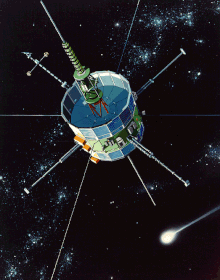21P / Giacobini-Zinner
| 21P / Giacobini-Zinner [i] | |
|---|---|

|
|
| Properties of the orbit ( animation ) | |
| Orbit type | short-term |
| Numerical eccentricity | 0.705 |
| Perihelion | 1.038 AU |
| Aphelion | 6.015 AU |
| Major semi-axis | 3.527 AU |
| Sidereal period | 6 a 227 d |
| Inclination of the orbit plane | 31.811 ° |
| Perihelion | September 10, 2018 |
| Orbital velocity in the perihelion | 34.61 km / s |
| Physical properties of the core | |
| Medium diameter | ~ 2 km |
| history | |
| Explorer | Michel Giacobini |
| Date of discovery | 20th December 1900 |
| Older name | - |
| Source: Unless otherwise stated, the data comes from JPL Small-Body Database Browser . Please also note the note on comet articles . | |
Giacobini-Zinner (official name 21P / Giacobini-Zinner ) is a short-period comet that was examined on September 11, 1985 by the ICE (International Cometary Explorer) space probe . It is the first comet ever to be explored by a probe.
In summer 2018 it reached the point of its orbit closest to the sun and was visible in binoculars. In 2025 he will go through his perihelion again.
discovery
The comet was discovered by Michel Giacobini on December 20, 1900 . Although the orbit determination indicated that it must be a short-period comet, the comet remained unobserved when it was predicted to return in 1907. Its next return was initially expected in 1914, but after Ernst Zinner had tracked down an unknown comet on October 23, 1913, it soon turned out that it was identical to Giacobini's comet from 1900. The comet has been named after the two discoverers ever since.
Orbit
Giacobini-Zinner runs in an elliptical orbit around the sun, whose point closest to the sun ( perihelion ) is just outside the orbit of the earth . The point furthest from the sun ( aphelion ) lies slightly outside the orbit of the planet Jupiter , which distinguishes it as a short-period comet of the Jupiter family .
The perihelion passage in 1946 was particularly noteworthy, as the comet then passed Earth at a distance of only 0.26 astronomical units . The comet achieved magnitudes in the 7th magnitude .
The comet is the mother body of the Draconiden (Giacobiniden) meteor shower that occurs in October . Usually only a few shooting stars can be seen per hour, but the fall rate can rise to a few hundred every few decades if the comet was close to Earth shortly before.
At its perigee in the summer of 2018 it reached a brightness of 8 mag and was visible as a small cloud in good binoculars. A photo series of the "comet hunter" Michael Jäger can be seen in the comet forum of the VdS.
ICE space probe
Only about half a year before a fleet of various spacecraft to Halley's Comet explored in the spring of 1986, flew on September 11, 1985, the space probe ICE (International Cometary Explorer) 7,800 kilometers from the comet head removed by the tail of Giacobini-Zinner. It is the first comet ever to be explored by a probe. The space probe was originally designed under the name ISEE 3 to research the solar wind shortly before reaching the Earth's magnetic field . She was able to study the interaction of the solar wind and the interplanetary magnetic field with the tail of Giacobini-Zinner. A camera for taking pictures was not on board. It was found that the comet's area of influence was larger than anticipated, and that the solar wind's magnetic field changed direction as ICE passed the center of the tail. ICE could not measure a clear bow shock when the solar wind hit the sphere of influence of Giacobini-Zinner.
See also
Web links
- Gary W. Kronk's Cometography - 21P / Giacobini-Zinner (English)
- Spektrum.de : Amateur recordings: 1 , 2 , 3 , 4
Individual evidence
- ↑ 21P / Giacobini-Zinner - Perihel 2018 - Forum of the Association of Star Friends. Retrieved October 9, 2018 .
- ↑ Nigel Calder : Beyond Halley . Springer, Berlin Heidelberg 1994, ISBN 3-540-57585-5 , p. 84.
